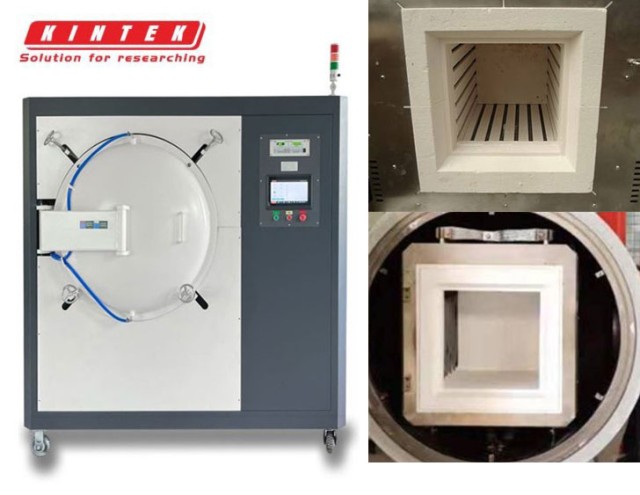진공로 유형 및 일반 응용 분야
진공로의 일반적인 공정
진공로는 다른 열처리 장비의 성능을 뛰어넘는 다양하고 복잡한 열처리 공정을 수행할 수 있는 다목적 장비입니다. 이러한 공정에는 진공 담금질 및 템퍼링, 진공 어닐링, 진공 용액 및 노화 처리, 진공 소결, 진공 화학 열처리 및 진공 코팅이 포함됩니다. 이러한 각 공정은 다양한 산업 응용 분야에서 중요한 역할을 하며, 재료가 정밀하고 제어된 변형을 거치도록 보장합니다.
진공로의 일반적인 워크플로는 몇 가지 주요 단계로 나눌 수 있습니다:
-
퍼니스 로딩: 이 프로세스는 부품, 도구 또는 구성 요소를 챔버에 넣는 것으로 시작됩니다. 퍼니스 크기에 따라 대형 퍼니스의 경우 롤링 랙이나 트레이를 사용하여 이 작업을 수행할 수 있고, 소형 유닛의 경우 챔버를 열고 내부에 부품을 배치하는 것만으로도 가능합니다.
-
챔버 내부에 진공 만들기: 챔버를 밀봉한 후 다음 단계는 챔버 내부에 진공을 만드는 것입니다. 이는 펌프를 초기화하여 모든 산소를 제거하고 밀폐 상태를 유지함으로써 이루어집니다. 진공 수준은 펌프 시스템의 크기와 작업 부하에 존재하는 오염 물질의 특성에 따라 1.3 x 10^-3 mbar(0.001 torr)에서 6.7 x 10^-3 mbar(0.005 torr)까지 다양하며 일반적으로 10~30분 이내에 도달할 수 있습니다.
-
부품 가열: 진공이 설정되면 질소, 아르곤 또는 질소/수소 혼합물(최대 3%)과 같은 불활성 가스로 퍼니스에 66.7 x 10^1 mbar(500 torr) 음압에서 0.10 bar(1.5 psig) 양압의 압력 범위까지 다시 채웁니다. 그런 다음 가열이 시작되며, 전체 사이클 시간을 단축하기 위해 두 번의 펌프다운 사이클이 포함되는 경우가 많습니다. 부품은 필요한 온도로 가열되고 균일한 온도 분포를 보장하기 위해 담궈집니다.
-
냉각 및 마감: 설정 온도에 도달하여 담근 후 냉각 사이클이 시작됩니다. 이 단계는 급속 냉각, 제어 냉각 또는 기타 특정 냉각 프로토콜 등 재료의 최종 특성을 결정하기 때문에 매우 중요합니다.
진공 환경에서 이러한 복잡한 공정을 수행할 수 있기 때문에 진공로는 정밀도와 재료 무결성이 가장 중요한 산업에서 필수 불가결한 장비입니다.
진공로의 분류
진공로는 여러 유형으로 분류되며, 각 유형은 특정 산업 분야에 맞게 설계되었습니다. 여기에는 진공 브레이징로, 진공 공기 담금질로, 진공 소결로, 진공 어닐링로, 진공 템퍼링로, 진공 오일 담금질로, 진공 침탄로 등이 포함됩니다.
진공 소결로
진공 소결로는 특히 가열 방식에 따라 분류되는 특수한 용광로입니다:
- 저항 가열로: 저항선 또는 전극을 가열원으로 사용하여 균일한 가열과 간단한 제어가 가능하며 다양한 재료에 적합합니다.
- 인덕션 퍼니스: 전자기 유도를 이용한 빠른 가열로 국소 가열이 가능하며 특정 재료에 이상적입니다.
- 전자빔 퍼니스: 전자빔을 사용하여 매우 빠르게 가열하고 고온을 달성할 수 있어 고온 내화성 재료에 적합합니다.
또한 진공 소결로는 작동 온도에 따라 분류할 수 있습니다:
- 저온 진공 소결로: 1000°C 이하에서 작동하며 저온 소결 재료에 이상적입니다.
진공 어닐링 용광로
진공 어닐링 퍼니스는 크게 다음과 같이 분류됩니다:
- 수평 진공 어닐링로: 스테인리스 스틸, 셀레늄 스틸 코어, 귀금속 부품, 은-구리 복합 리벳 및 시트와 같은 특수 소재의 진공 어닐링에 사용됩니다.
- 웰형 진공 어닐링로: 배관 장비의 딥 드로잉 부품을 위해 특별히 설계되어 산화되지 않은 표면과 높은 생산성을 보장합니다.
이러한 분류는 다양한 산업 공정에서 진공 용광로의 다양한 응용 분야와 특수 기능을 강조합니다.
다양한 진공 용광로의 특정 응용 분야
진공 브레이징로
진공 브레이징로는 제어된 진공 환경에서 브레이징 공정을 수행하도록 설계된 특수 장비입니다. 이러한 진공 환경은 산화를 방지하기 위해 기존 브레이징 방법에서 일반적으로 사용되는 플럭스가 필요 없기 때문에 매우 중요합니다. 진공 브레이징 공정은 플럭스 필요성을 제거함으로써 조인트에 오염 물질이 없고 깨끗한 상태를 유지하여 고품질의 내구성 있는 결합을 보장합니다.
이 유형의 퍼니스는 특히 정밀한 온도 제어가 필요한 복잡한 부품과 민감한 재료를 납땜하는 데 적합합니다. 항공우주, 자동차, 전자 등 접합부의 무결성이 가장 중요한 산업에서 광범위하게 사용됩니다. 진공 브레이징로는 알루미늄 합금, 스테인리스 스틸, 티타늄 합금, 초경합금, 고온 합금, 비철금속 등 다양한 재료를 취급할 수 있습니다.
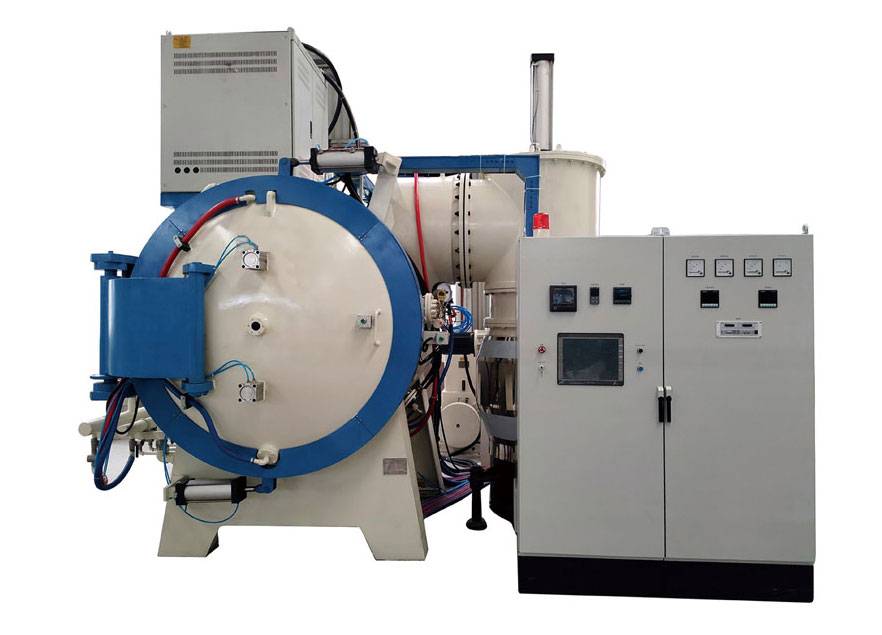
주요 애플리케이션
-
알루미늄 합금 열교환기: 진공 브레이징로는 주로 알루미늄 합금 열교환기 및 기타 알루미늄 제품을 브레이징하는 데 사용됩니다. 이 응용 분야는 열교환기가 견고하고 효율적이며 고성능 환경에 적합하도록 보장합니다.
-
스테인리스 스틸 및 티타늄 합금: 이러한 소재는 강도와 내식성이 중요한 고응력 애플리케이션에 자주 사용됩니다. 진공 브레이징 공정은 이러한 소재의 특성을 손상시키지 않고 접합할 수 있도록 보장합니다.
-
고속강 및 다이강: 공구와 금형의 경우 진공 브레이징 용광로는 공구의 선명도와 내구성을 유지하는 데 필요한 정밀도와 청결도를 제공합니다.
-
진공 템퍼링: 진공 브레이징로는 브레이징 외에도 고속강, 다이강, 베어링강 등 다양한 소재의 진공 템퍼링에도 사용할 수 있습니다. 이러한 이중 기능 덕분에 재료 가공에서 다목적 도구로 활용됩니다.
진공 브레이징 공정
진공 브레이징 공정에는 성공적인 브레이징을 위한 몇 가지 중요한 단계가 포함됩니다:
-
청소 및 준비: 첫 번째 단계는 접합할 부품을 철저히 세척하는 것입니다. 이 단계는 브레이징 공정을 방해할 수 있는 오일, 그리스 또는 산화물과 같은 오염 물질을 제거하는 데 필수적입니다. 일반적인 세척 방법에는 초음파 세척, 증기 탈지, 화학적 에칭 등이 있습니다.
-
조립 및 고정: 세척 후 부품을 조립하고 고정하여 브레이징 공정 중에 적절한 정렬과 간격을 유지합니다. 고정 장치는 일반적으로 열팽창 계수가 낮은 재료로 만들어져 가열 공정 중 뒤틀림이나 정렬 불량을 방지합니다.
이러한 단계를 따르면 진공 브레이징로는 최종 제품이 다양한 산업 응용 분야의 엄격한 요구 사항을 충족하여 복잡한 부품을 결합하는 데 안정적이고 내구성 있는 솔루션을 제공합니다.
진공 담금질로
진공 담금질로는 고정밀 열처리 공정을 위해 설계된 특수 장비입니다. 이 퍼니스는 특히 고속강, 공구강, 금형강, 합금 구조강 및 기타 유사한 재료를 처리하는 데 능숙합니다. 진공 담금질로의 주요 기능은 고압 가스 담금질을 수행하여 재료가 정밀하고 제어된 냉각을 거치도록 하여 기계적 특성을 향상시키는 것입니다.
진공 담금질로는 고압 가스 담금질 외에도 스테인리스 스틸 소재의 고온 브레이징, 고용체 처리 및 분말 소재 소결에도 활용될 수 있습니다. 이 다목적 용광로는 어닐링과 용액 고속 냉각이 모두 가능하므로 고급 열처리 공정이 필요한 산업에서 없어서는 안 될 필수 요소입니다.
진공 담금질 용광로의 독특한 설계와 고급 성능은 고속강, 금형강, 스테인리스강, 합금강 및 티타늄 합금과 같은 고정밀 부품에 대한 광범위한 진공 브라이트 가스 담금질 기능을 제공합니다. 이를 통해 처리된 부품이 최소한의 변형으로 무결성과 정밀도를 유지할 수 있습니다.
또한 KinTek 소프트웨어와 같은 고급 제어 시스템의 통합은 이러한 용광로의 전반적인 자동화 및 제어를 향상시킵니다. 이러한 시스템은 사실적인 애니메이션 효과와 개인화된 기능 속성을 제공하여 퍼니스의 작동을 보다 실용적이고 쉽게 관리할 수 있게 해줍니다.
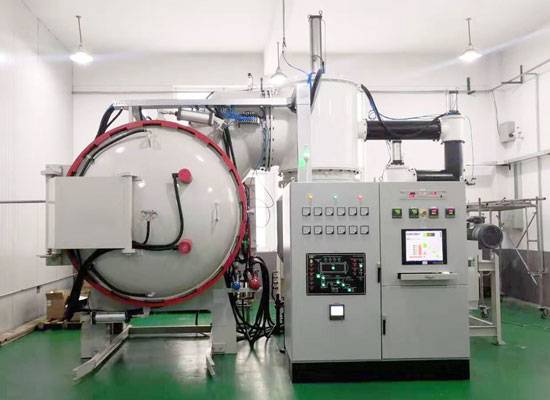
진공 담금질로는 가스 담금질에만 국한되지 않고 오일 담금질도 수행할 수 있어 다양한 냉각 매체를 필요로 하는 재료에 특히 유용합니다. 이러한 이중 기능 덕분에 침탄강 및 합금 공구강부터 고속강 및 스테인리스강에 이르기까지 다양한 소재를 효과적으로 처리할 수 있습니다.
요약하면 진공 담금질로는 첨단 열처리 분야에서 필수적인 도구로, 다양한 산업 요구 사항을 충족하는 포괄적인 공정 제품군을 제공합니다. 고압 가스 담금질, 고온 브레이징, 고용체 처리 및 분말 재료 소결을 수행할 수 있는 능력과 첨단 제어 시스템의 통합으로 현대 제조 및 재료 과학의 초석이 되고 있습니다.
진공 소결로
진공 소결로는 진공 상태에서 작동하며, 종종 수소 보호 기능이 추가되어 섬세하고 복잡한 부품을 소결할 수 있는 최적의 환경을 조성합니다. 이 용광로는 코일 내부에 위치한 텅스텐 도가니에서 고온을 발생시키는 중주파 유도 가열을 사용합니다. 이 열은 열 복사를 통해 공작물, 일반적으로 과학 연구 및 군사 응용 분야에서 중요한 텅스텐, 몰리브덴 및 그 합금과 같은 내화성 합금으로 전달됩니다.
진공 소결 공정은 전통적인 주조나 기계 가공으로 제조하기 어려운 부품을 생산하는 데 특히 유리합니다. 최소한의 폐기물로 부품을 효율적으로 접합할 수 있어 이음새, 접합부 또는 필러가 없는 일관되고 밝은 부품을 만들 수 있습니다. 이 방법은 분말 금속, 금속 사출 성형, 3D 프린팅과 같은 기술에 매우 유용하며 품질과 유연성을 모두 향상시킵니다.
진공 소결로에는 수평형과 수직형의 두 가지 주요 유형이 있습니다. 이러한 유형 중 선택은 소결 공정의 특정 요구 사항과 작업 공간의 레이아웃에 따라 달라집니다. 이러한 용광로의 설치 장소는 엄격한 진공 건강 표준을 준수해야 하며, 오염과 먼지 축적을 방지하기 위해 주변 공기가 깨끗하고 건조하며 환기가 잘 이루어지도록 해야 합니다.
진공 소결로 사용의 이점은 다양합니다. 놀라운 설계 유연성, 빠른 처리 시간, 우수한 품질, 적은 결함 등을 제공합니다. 또한 이 퍼니스는 유지 관리가 비교적 쉬워 생산성을 극대화하는 데 기여합니다. 소결 공정 자체는 분말 재료를 고밀도 고성능 부품으로 전환하는 중요한 단계인 디바인딩으로 시작됩니다. 이 공정은 재료의 미세 구조에 큰 영향을 미치며 입자 크기, 기공 크기, 입자 경계 분포에 영향을 미치고 최종 제품의 전반적인 특성에 영향을 미칩니다.
진공 어닐링로
진공 어닐링 퍼니스는 다양한 재료, 특히 스테인리스 스틸 및 기타 고정밀 금속 부품에 대해 비산화 어닐링 공정을 수행하도록 설계된 특수 장비입니다. 이 퍼니스는 스테인리스 스틸 베어링, 절삭 공구, 셀프 태핑 셀프 드릴링 나사, 스테인리스 스틸 다웰 등을 취급하는 산업에 필수적입니다. 진공 어닐링 퍼니스의 주요 기능은 고온 처리 중 산화를 방지하여 이러한 부품의 무결성과 표면 품질을 유지하는 것입니다.
진공 어닐링 퍼니스의 두드러진 특징 중 하나는 일반적으로 고순도 질소 또는 암모니아 분해 가스를 사용하는 보호 분위기에서 작동할 수 있다는 점입니다. 이러한 보호 환경은 처리되는 재료에 오염 물질과 산화가 발생하지 않도록 하여 밝고 흠 잡을 데 없는 표면 마감을 보장합니다. 교반 팬을 사용하면 용광로 온도의 균일성이 더욱 향상되어 모든 구성 요소에 걸쳐 일관된 처리가 보장됩니다.
진공 어닐링 퍼니스는 스테인리스 스틸에 적용될 뿐만 아니라 기계 부품, 실리콘 강판, 다양한 구리 및 와이어 소재의 비산화 브라이트 어닐링에도 활용됩니다. 이러한 다용도성 덕분에 자동차 및 항공우주부터 전자 및 정밀 엔지니어링에 이르기까지 다양한 분야에서 중요한 도구로 사용되고 있습니다.
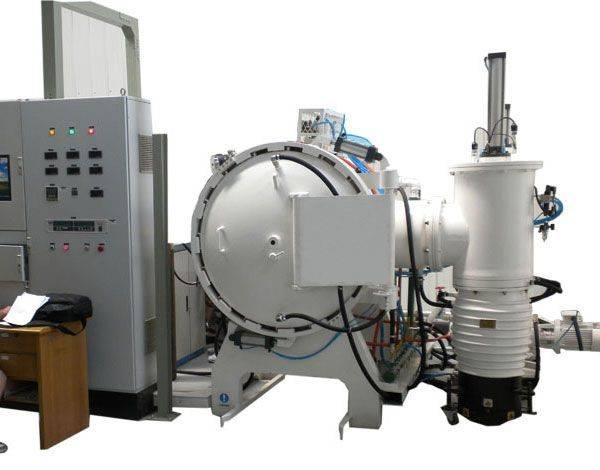
진공 어닐링 퍼니스는 스테인리스강 응용 분야에 국한되지 않고 티타늄, 지르코늄 및 내화 합금과 같은 다른 재료로 그 기능을 확장합니다. 분말 야금 분야에서는 활성 및 반응성 금속을 소결하는 데 중요한 역할을 하여 이러한 재료가 구조적 무결성과 기계적 특성을 유지하도록 보장합니다.
또한 진공 어닐링 퍼니스는 진공 또는 보호 분위기에서 작동할 수 있기 때문에 고온에서 가스 반응을 피하는 것이 가장 중요한 고정밀 응용 분야에 이상적입니다. 이 기능은 처리된 부품이 항공우주, 의료 기기 및 첨단 전자 제품과 같은 산업에서 요구하는 엄격한 품질 표준을 충족하도록 보장합니다.
요약하면, 진공 어닐링 퍼니스는 다양한 산업 공정에서 높은 생산성, 우수한 표면 품질, 다양한 재료를 처리할 수 있는 능력을 제공하는 다용도 필수 도구입니다. 보호 분위기와 온도 균일성 기능 덕분에 고가 부품의 정밀도와 무결성을 유지하는 데 선호되는 선택입니다.
진공 템퍼링로
진공 템퍼링 퍼니스는 밝고 산화가 없는 표면으로 부품을 템퍼링해야 하는 까다로운 요구 사항을 충족하도록 설계된 특수 장비입니다. 이 퍼니스는 특히 금형강, 고온 합금, 탄성 합금, 구리 합금, 티타늄 합금, 다양한 구리 및 구리 합금의 고온 템퍼링 처리에 능숙합니다. 이 공정은 처리된 부품의 구조적 무결성과 기계적 특성을 유지할 뿐만 아니라 표면 산화의 위험을 제거하여 깨끗한 마감을 보장합니다.
진공 템퍼링로는 고온 응용 분야 외에도 응력 제거 및 연화 어닐링 공정에도 사용됩니다. 이 이중 기능은 정밀 공구 및 부품 제조와 같이 강도와 유연성이 모두 필요한 소재에 매우 중요합니다. 소재를 빠르게 냉각하는 퍼니스의 기능은 최종 제품이 내구성이나 성능 저하 없이 원하는 특성을 유지하도록 보장합니다.
이러한 용광로 내의 진공 환경은 이러한 결과를 달성하는 데 중추적인 역할을 합니다. 대기 중 산소를 제거함으로써 표면 산화의 위험이 사실상 제거되어 일관되게 밝고 흠집 없는 마감의 부품을 제작할 수 있습니다. 이는 항공우주 및 의료 기기 분야와 같이 부품의 미적, 구조적 무결성이 가장 중요한 산업에서 특히 중요합니다.
또한 가열 및 냉각 속도를 정밀하게 제어하면 원치 않는 응력이나 변형 없이 재료가 필요한 변형을 거칠 수 있습니다. 이러한 수준의 제어는 최종 제품의 치수 정확도와 기계적 특성을 유지하는 데 필수적이므로 진공 템퍼링로는 고정밀 제조 공정에서 없어서는 안 될 필수 도구입니다.
진공 오일 담금질로
진공 오일 담금질로는 금형강, 스프링강, 스테인리스강, 베어링강, 고온 합금강 등 다양한 고성능 강재의 진공 열처리를 위해 설계된 특수 장비입니다. 이 유형의 용광로는 진공 열처리와 어닐링 공정을 결합하여 재료 경화 및 템퍼링을 위한 다목적 솔루션을 제공하는 능력으로 특히 가치가 높습니다.
진공 오일 담금질로의 주요 장점 중 하나는 다양한 강종에 폭넓게 적용 가능하다는 점입니다. 이 퍼니스는 뛰어난 경화성을 보장하도록 설계되어 최적의 기계적 특성을 얻기 위해 정밀한 열처리가 필요한 다양한 소재에 적합합니다. 또한 이 공정은 사용된 담금질 오일을 재활용 및 재사용할 수 있어 운영 비용과 환경에 미치는 영향을 줄일 수 있다는 점에서 비용 효율성이 뛰어납니다.
하지만 진공 오일 담금질 용광로에도 한계가 없는 것은 아닙니다. 가장 큰 단점은 담금질 과정에서 상대적으로 높은 수준의 변형이 발생한다는 점입니다. 이러한 변형으로 인해 공작물을 원하는 치수와 표면 품질로 복원하기 위해서는 후속 세척 및 추가 마감 단계가 필요합니다.
구조적 관점에서 진공 오일 담금질로는 2챔버와 3챔버 설계로 분류할 수 있습니다. 이러한 구성은 다양한 운영 효율성과 공간 활용도를 제공하여 다양한 생산 요구 사항과 공작물 크기를 충족합니다.
안전성과 효율성 측면에서 진공 오일 담금질로의 작동에는 냉각 공정 중에 질소 사용이 포함됩니다. 오일 냉각 챔버에 0.4-0.67 x 10^5 Pa(300-500 Torr)의 압력 범위에서 질소를 충전함으로써 퍼니스는 담금질 오일의 냉각 용량을 향상시킵니다. 이는 공작물이 정상 압력에서 원하는 담금질 경도를 달성하는 데 도움이 될 뿐만 아니라 담금질 오일의 휘발을 크게 감소시켜 오일 분무를 최소화하고 전반적인 안전성을 향상시킵니다. 질소 보조 냉각 방식은 또한 오일 손실을 줄이고 용광로 내 오염을 줄여 궁극적으로 제품 품질과 운영 안전에 도움이 됩니다.
진공 침탄로
진공 침탄로는 열처리 공정 영역에서 진공 침탄, 진공 탄화, 침탄과 오일 또는 가스 담금질의 조합 등 무수히 많은 작업을 수행할 수 있는 다목적 도구로 각광받고 있습니다. 이러한 유연성은 진공로의 부서별 기능으로 확장되어 열처리가 필요한 다양한 재료 및 부품의 산업 응용 분야에서 초석이 됩니다.
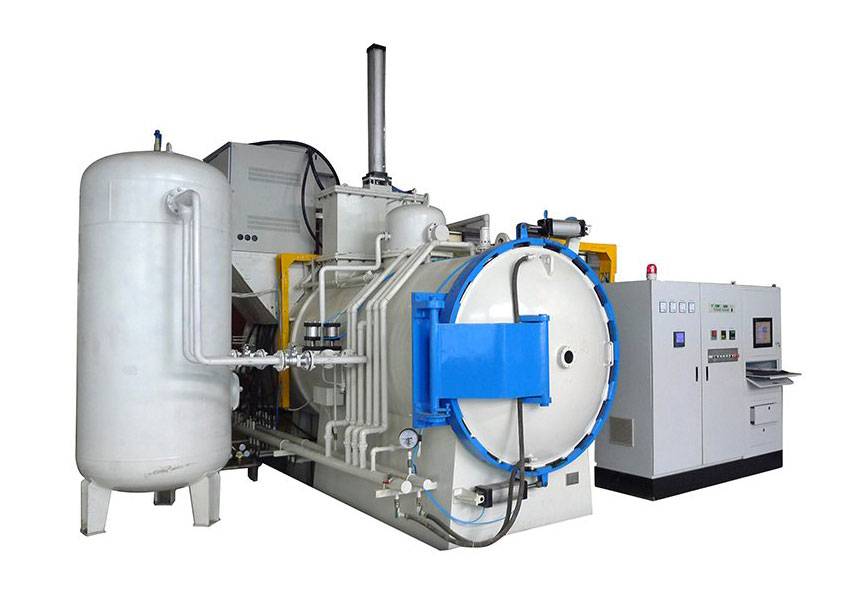
진공 침탄의 주요 장점 중 하나는 CO2 배출 없이 작동하기 때문에 기존의 대기 침탄 방식과 차별화되는 친환경성입니다. 이 공정은 통제된 저압 환경에서 일반적으로 900~1,000°C의 온도로 강철 부품을 가열합니다. 표면층에 탄소를 주입하여 가단성을 유지하면서 경도와 내마모성을 향상시키는 것이 목표입니다. 침탄 후 경화 및 템퍼링은 일반적으로 진공 환경과 아세틸렌(C2H2)과 같은 운반 가스의 이점을 활용하여 수행됩니다.
진공 침탄의 적용 분야는 12Cr2NI4A 및 12CrNi3A와 같은 고합금 침탄강부터 20CrMnTi와 같은 구조강, 심지어 1Cr13과 같은 스테인리스강에 이르기까지 매우 광범위합니다. 또한 H13 및 W6Mo5Cr4V2와 같은 금형강은 물론 기어, 부싱, 정밀 베어링, 오일 펌프, 노즐 및 기타 정밀 기계 부품과 같은 부품의 열처리에도 필수 불가결한 요소입니다. 이러한 광범위한 적용성은 다양한 산업 부품의 내구성과 성능을 보장하는 데 있어 진공 침탄로의 중추적인 역할을 강조합니다.
관련 제품
- 진공 열처리 소결 브레이징로
- 진공 열간 프레스 퍼니스 기계 가열 진공 프레스
- 진공 아크 유도 용해로
- 고온 응용 분야를 위한 진공 열처리 및 압력 소결로
- 진공 열간 프레스 퍼니스 가열 진공 프레스 기계 튜브 퍼니스
